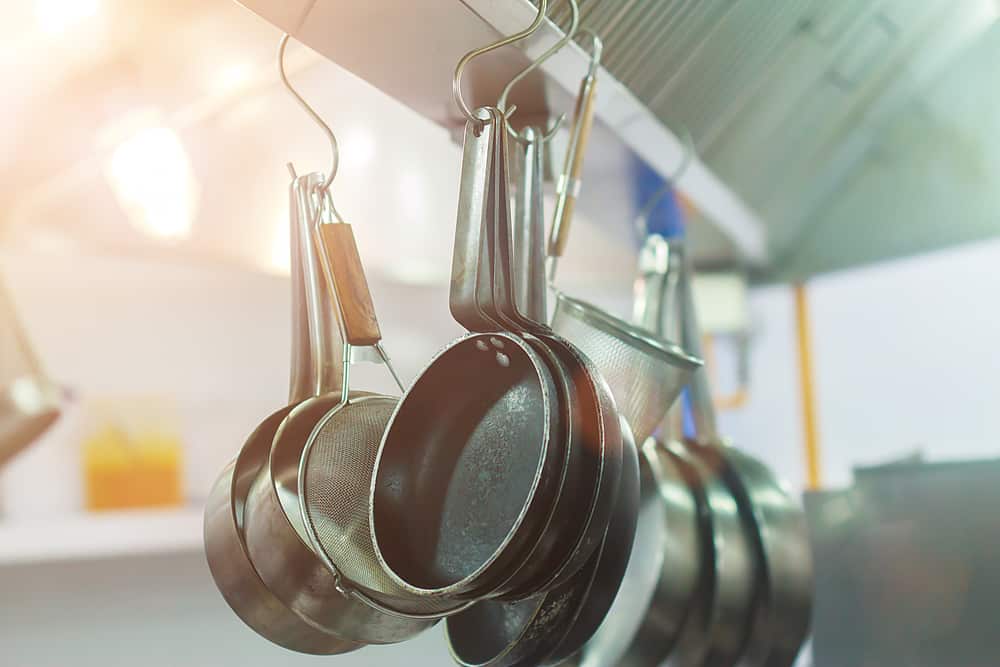
Most kitchens today have some form of metal cookware. While cast iron, enamelware, glass and copper are available, stainless steel remains a popular choice for pots and pans.
Stainless steel cookware is extremely durable and offers excellent cooking performance in terms of heat distribution and absorption. It is very easy to clean because it’s non-porous and smooth-surfaced.
Stainless steel cookware also requires little maintenance over its lifetime. However, cooking with these pans can cause a metallic flavor in the food, particularly if the food contains acid as with tomatoes.
Some readers have asked us to explore smell issues on their stainless steel cookware so if you’re struggling with the same thing, keep reading because we have information that can help.
Stainless Steel Pan Smells
- Basic Cleanup
Try to clean your cookware immediately after use. Although the cookware is non-porous and could technically be cleaned later, it’s always easier to get the job done before the food hardens.
Ordinary dishwashing liquid and hot water are the only cleaning products needed for normal cleaning purposes. Use a sponge pad, firm brush or dishrag.
You can use a scouring sponge or even steel wool on stainless steel cookware to remove burnt food but remember that it may leave scratches. Rinse after cleaning. This should take care of all dirt and most odors but if you are still having odor problems, keep reading.
- Chlorine Bleach
After you have cleaned the stainless steel pan is clean, you can opt for a chlorine bleach rinse. This is useful if you have cooked fish and want to remove all traces of the smell.
Make up a solution of two tablespoons of household chlorine bleach to a gallon of water. Pour this into the pan and soak it for an hour. Rinse the pan well in clean water and leave it upside down to dry.
Baking soda is also a great odor-removing option. Sprinkle a tablespoon or two of baking soda into the pan, spread it around with a sponge, and then leave it overnight. In the morning, rinse away all traces of baking soda and bad smells with clean water.
Upon contact, the baking soda will eliminate the odors, and prolonged exposure will help eliminate the stubborn smells. Baking soda will not damage the surface of your stainless steel cookware.
- Vinegar
To ensure proper cleaning of the stainless steel pan, you can opt for vinegar. This is a suitable choice for people who want a non-bleach cleaner. You need to mix about a tablespoon of vinegar with a teaspoonful of liquid detergent and enough baking soda to create a thick paste.
Apply the paste all over the stainless steel pan and leave it for two to three hours. After this time, rinse off this mixture and scrub the surface using a scouring pad. Any traces of odor and stains will be gone.
Lemon juice has a wonderful fresh smell of its own and is gentle on your cookware and your hands. Simply take half a fresh lemon and rub the cut side all over the pan.
Squeeze as much juice as you can out of the shell and leave the pan for half an hour or so. Then rinse in cold water and you’ll be left with a fresh smelling, sparkling pan.
To Conclude
As you can see, there are several ways of removing unpleasant odors from your stainless steel cookware. They’re all inexpensive and easy.
Remember that because stainless steel isn’t porous, it cannot absorb odors so thorough cleaning will always eliminate them. To ensure that the smell issue doesn’t occur again, we suggest that you clean the pans as soon as you are done cooking.

